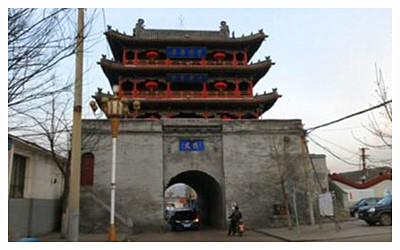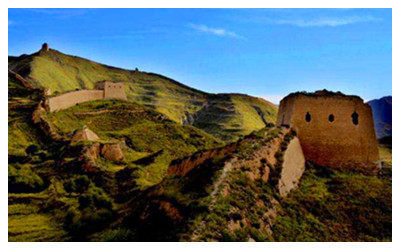Skype: neodalle-travel
Tel: +86 135 7447 2266
E-mail: sales@visitaroundchina.com
 Ningwu Pass was first constructed in 1450 during the Ming Dynasty, and was renovated and enlarged many times. In a rectangular shape, it originally had three gates in total: the East Gate, the South Gate, and the West Gate. In 1479, the North Gate was opened. Many emplacements and watch towers were also built along the wall of the pass. After the enlargement in 1498, the pass had a girth of 3.5 kilometers and its wall was about 11.5 meters high. In 1606, the rammed earth wall was wrapped by bricks, making it more solid and sound. The East Gate Tower and West Gate Tower were also constructed. At the top of the Huagai Mountain was erected a magnificent three-storey Fire Tower. Additionally, the 20 kilometers long Great Wall was built to the north of the pass.
Ningwu Pass was first constructed in 1450 during the Ming Dynasty, and was renovated and enlarged many times. In a rectangular shape, it originally had three gates in total: the East Gate, the South Gate, and the West Gate. In 1479, the North Gate was opened. Many emplacements and watch towers were also built along the wall of the pass. After the enlargement in 1498, the pass had a girth of 3.5 kilometers and its wall was about 11.5 meters high. In 1606, the rammed earth wall was wrapped by bricks, making it more solid and sound. The East Gate Tower and West Gate Tower were also constructed. At the top of the Huagai Mountain was erected a magnificent three-storey Fire Tower. Additionally, the 20 kilometers long Great Wall was built to the north of the pass.
In 1644, a fierce battle took place at Ningwu Pass. The peasant rebels led by Li Zicheng fought against the guarding soldiers led by General Zhou Yuji. The fight lasted seven days and the General Zhou Yuji was defeated and killed. The rebels marched to Beijing, the capital city. Then, they overthrew the Emperor, putting an end to the Ming Dynasty. Nowadays, you can see the Tomb of General Zhouyuji stands quietly to the east of the Huihe River.
What to see?
As time passed, the Ningwuguan Pass has fallen into disrepair. Today, you can see some relics of the rammed earth wall. Fortunately, the Drum Tower, the representative building, is well-preserved.
Drum Tower
The three-storey Drum Tower stands on Renmin Avenue at the Ningwu County. It is in a square shape, with a height of 98 feet (30 meters). The cross-shaped pedestal is made of bricks and stones. There are many cultural relics on show, such as weapons and articles for daily use from ancient times.
Yangfangkou Fort
 There are many forts along the Great Wall at Ningwuguan, and Yangfangkou Fort is the largest one among them. It was constructed in 1539, and enlarged in 1576, with a length of 0.6 mile (1 kilometer). It lies between Changfang Mountain and Huihe River, about 8 miles (18 kilometers) to the north of the Ningwu County. It was historically called Jiuniukou Fort, meaning Nine Cows Fort. There was a nine-span stone bridge, and it was connected with the Great Wall to its two sides. Each span is supported by a cow-shaped iron pedestal. Later, the pedestals were washed away, and the bridge collapsed. Thereafter, the fort was renamed as "Yangfangkou Fort", which means a fort defended by the Yang Family. It was renamed so because the Generals of the Yang Family guarded there.
There are many forts along the Great Wall at Ningwuguan, and Yangfangkou Fort is the largest one among them. It was constructed in 1539, and enlarged in 1576, with a length of 0.6 mile (1 kilometer). It lies between Changfang Mountain and Huihe River, about 8 miles (18 kilometers) to the north of the Ningwu County. It was historically called Jiuniukou Fort, meaning Nine Cows Fort. There was a nine-span stone bridge, and it was connected with the Great Wall to its two sides. Each span is supported by a cow-shaped iron pedestal. Later, the pedestals were washed away, and the bridge collapsed. Thereafter, the fort was renamed as "Yangfangkou Fort", which means a fort defended by the Yang Family. It was renamed so because the Generals of the Yang Family guarded there.
The Yangfangkou Fort served as an important spot for transportation in the ancient times. Today, it is a transport hub between Taiyuan and Datong. The gate of the fort still remains. Also, you can see the dilapidated Great Wall and three well-preserved watchtowers there.
Apart from these wonders of human construction, you can enjoy the intoxicating natural landscapes near the pass. The Guanceng Mountain, the main peak of the Luya Mountain, is home to the only virgin forest along the Great Wall of China. You can also see many beautiful lakes there.
Travel Tips
Add: in Ningwu County, Xinzhou of Shanxi Province.
Opening Hours: 08:00-17:00
Entrance Fees: CNY 30
 Ask Questions ?
Ask Questions ?